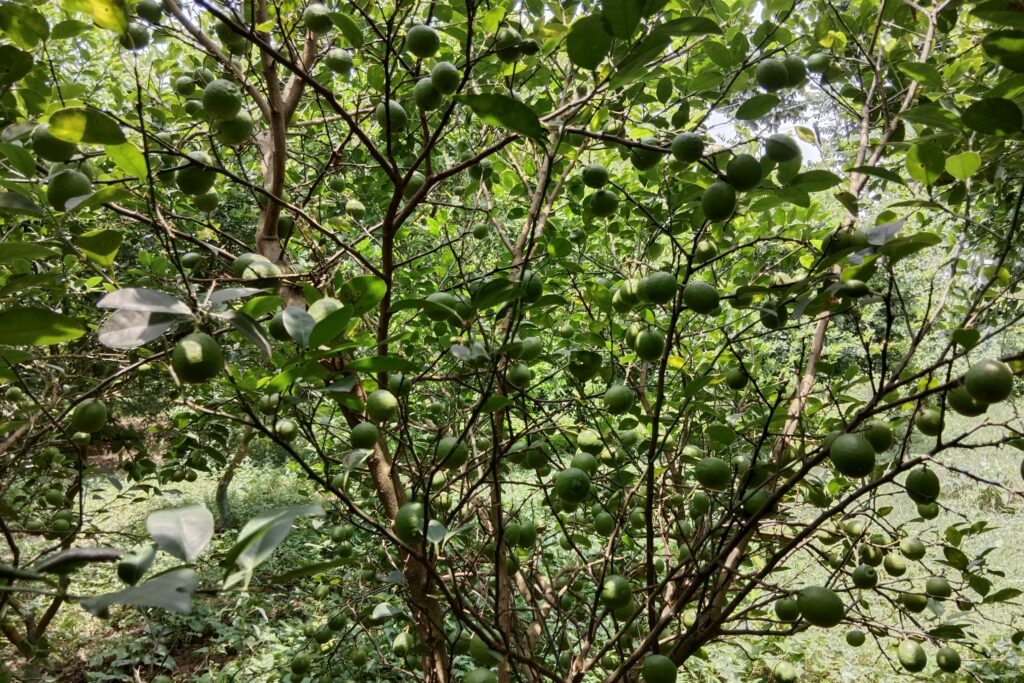Sorrel Farming
Sorrel is a hardy, short-day plant prized for its fleshy red calyces, which are used in beverages, jams, jellies, and medicinal products, and although it is relatively easy to grow, achieving optimal yield requires following specific cultivation practices.
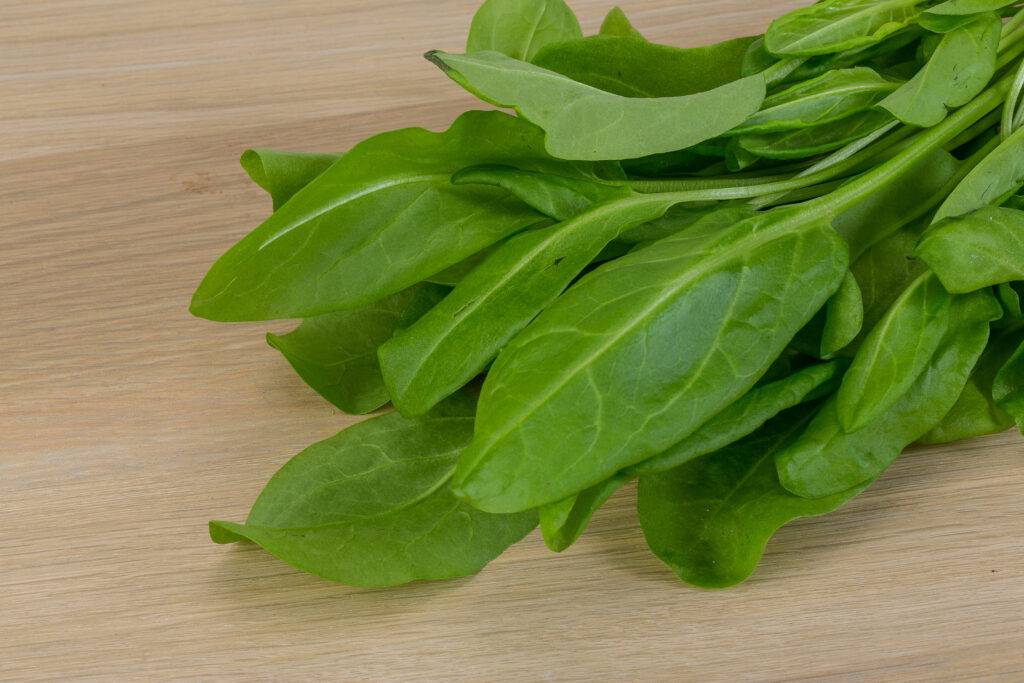
Sorrel farming profit per acre is significant, as cultivating one acre requires a total investment of NRs 40,000 and can generate a total income of NRs 100,000, resulting in a net profit of NRs 60,000 per acre and a 150% return on investment; this high profitability is due to moderate input costs and the strong market value of sorrel calyces, while proper management of irrigation, pest control, and timely harvesting is crucial to maintain yields and maximize returns.
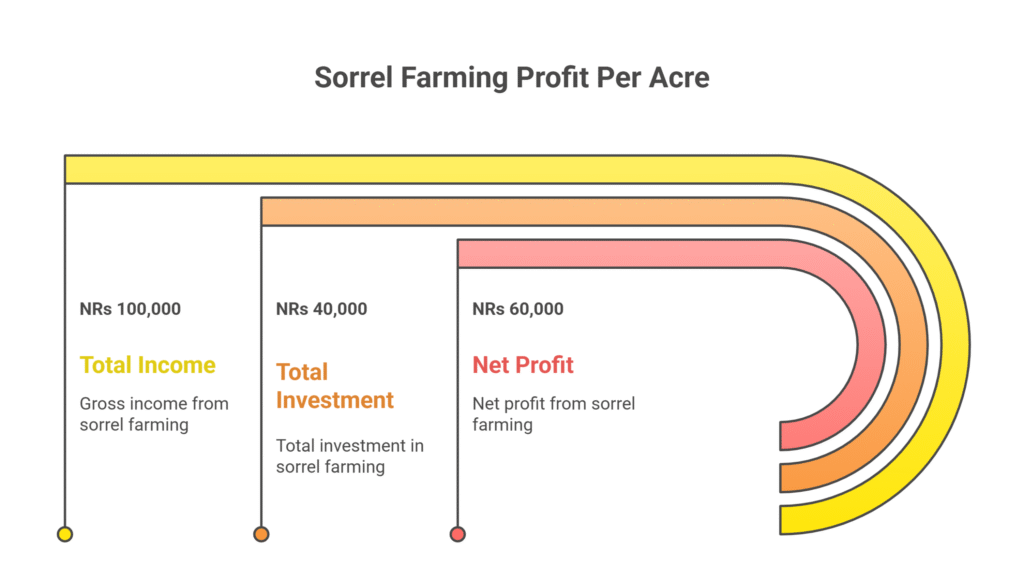
Land Preparation
Land preparation aims to create a fine, well-aerated, and weed-free seedbed that supports strong root development and efficient water infiltration. The process begins with clearing the field of previous crop residues, weeds, and stones, followed by a deep ploughing (20–30 cm) to break up the soil and bury surface weeds. After ploughing, 2–3 rounds of harrowing or rototilling help reduce large soil clods and improve soil texture. In areas with heavy rainfall, raised beds or ridges are formed to avoid waterlogging, typically measuring about 1–1.2 meters in width and adjusted to a convenient working length.
Soil Type
Sorrel grows best in well-drained, fertile loamy soils rich in organic matter, though it can tolerate a wide range of soil types including sandy loam and clay loam. It is moderately tolerant to both soil acidity and alkalinity, but optimum growth occurs in soils with a pH between 5.5 and 6.8. Heavy, waterlogged clay soils should be avoided as they hinder root development and increase the risk of root rot diseases.
Climatic Requirements
Sorrel is a warm-season crop that thrives in temperatures between 20°C and 35°C and is extremely sensitive to frost, which can kill the plants. It requires moderate, well-distributed rainfall ranging from 1000 mm to 1500 mm, as drought during flowering and calyx formation can significantly reduce yields. As a short-day plant, sorrel initiates flowering under shorter day lengths but still needs full sunlight throughout most of the day to support vigorous growth.
Major Cultivars
Cultivars are typically differentiated by their stem color, which may be green or red, and by their calyx yield potential, allowing farmers to select varieties based on visual traits and expected productivity.
| Type/Variety | Characteristics | |
| Rico | High-yielding, early maturing, produces red calyces. | |
| Victor | Known for dark red calyces and strong, vigorous growth. | |
| Archer (White Sorrel) | Features green stems and yellow-green calyces; valued for tender leaves and shoots used as a vegetable. | |
| Local Landraces | Region-specific varieties often more resilient to local pests and climatic conditions. | |
Propagation
Sorrel is almost exclusively propagated by seeds. The seeds are viable for several years if stored in a cool, dry place.
Seed Rate per Acre
The recommended seed rate for sorrel is approximately 1.5 to 2 kg per acre, although the exact amount may vary depending on factors such as seed germination rate, planting spacing, and whether the crop is established through direct seeding or transplanting.
Nursery Management
Nursery management is used mainly for transplanting to ensure a uniform crop stand, particularly when working with hybrid seeds or in areas with a short rainy season. To establish a nursery, prepare raised beds using fine soil mixed with well-decomposed compost, then sow the seeds in rows spaced 5 cm apart and lightly cover them with soil. Water gently and consistently to maintain moisture without causing waterlogging. Seeds typically germinate within 5–10 days, and seedlings become ready for transplanting after 3–4 weeks when they reach a height of 10–15 cm and develop 4–5 true leaves.
Planting
a). Planting Season
Planting season for sorrel typically begins at the onset of the rainy season, and seeds can be started indoors three weeks before the last frost or directly sown in early spring, such as in March.
b). Planting Direction
Rows should be oriented to receive maximum sunlight. North-South orientation is generally recommended for even light distribution.
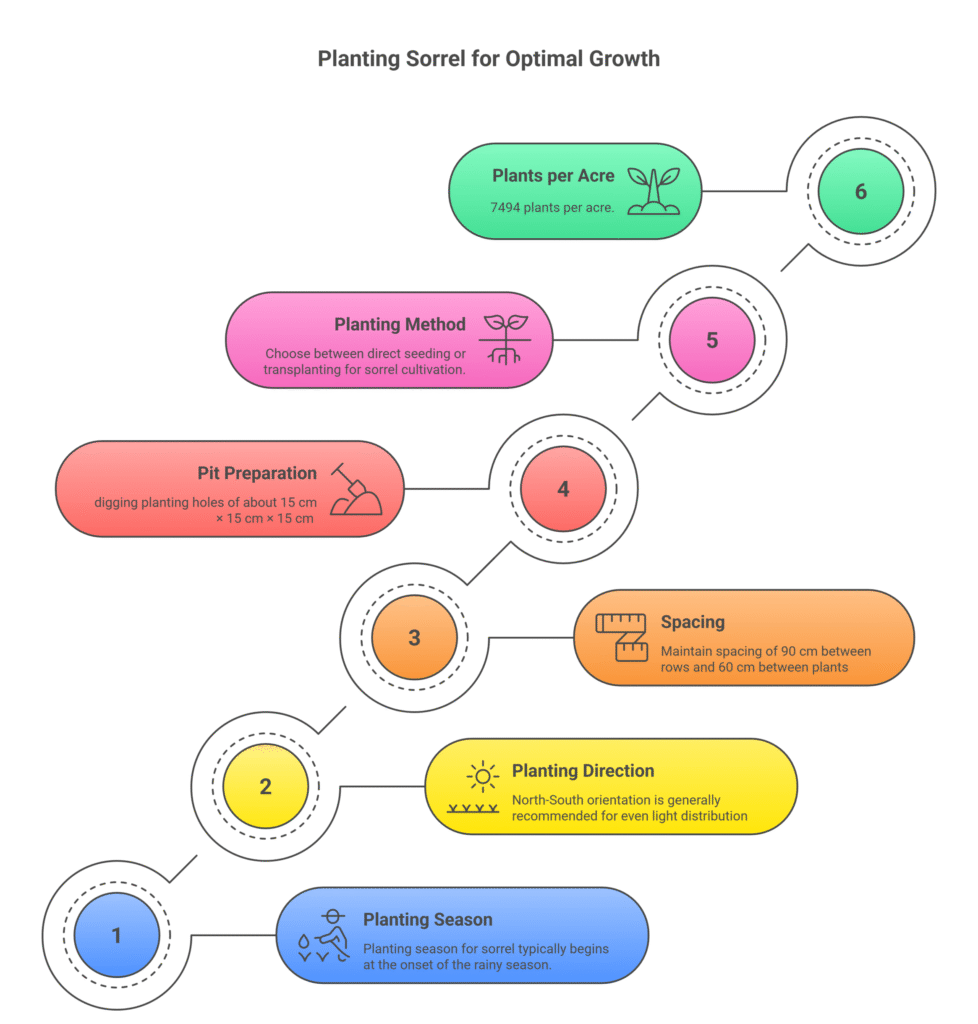
c). Spacing
Spacing for sorrel cultivation should be maintained at 90–120 cm between rows and 60–90 cm between individual plants to ensure proper growth and airflow.
d). Pit Preparation
Pit preparation involves digging planting holes of about 15 cm × 15 cm × 15 cm at the recommended spacing, then mixing the excavated soil with well-rotted manure or compost before refilling the pits.
e). Planting Method
| Planting Method | Description |
| Direct Seeding | Sow 2-3 seeds per hole at a depth of 1-2 cm, thinning to the strongest seedling after emergence. |
| Transplanting | Transplant healthy seedlings from the nursery into prepared pits, watering immediately after (known as “drenching”). |
f). Number of Plants per Acre
With a spacing of 90 cm x 60 cm, you can accommodate approximately 7494 plants per acre.
Intercropping
Intercropping sorrel is beneficial because its slow initial growth allows farmers to cultivate short-duration crops such as lettuce, radish, cucumber, or leafy greens between the rows during the first 6–8 weeks, which maximizes land use and provides an additional income stream before the sorrel matures.
Irrigation
Irrigation is essential for sorrel, especially during critical stages such as germination, seedling establishment, flowering, and calyx development, and it should be applied deeply 1–2 times per week depending on rainfall and soil type, with drip irrigation being highly efficient for conserving water and reducing weeds and foliar diseases, while watering should be reduced about 2–3 weeks before the main harvest to help concentrate flavors and sugars in the calyces.
Fertilizer and Manure
Fertilizer and Manure Application Schedule
| Category | Material / Nutrient | Rate per Acre | Timing / Method of Application |
| Organic Manure | Well-decomposed FYM or Compost | 10 – 15 tons | Basal Application: Incorporate into the soil during bed preparation. |
| Biofertilizers | Azospirillum | 800 grams | |
| Phosphobacteria (PSB) | 800 grams | Apply as a basal dose during planting. | |
| Potash Mobilizing Bacteria | 800 grams | ||
| Inorganic Fertilizer | Nitrogen (N) | 40 – 50 kg | Basal Dose (at planting): Apply half of the total N (20-25 kg). Top-Dressing: Apply the remaining half (20-25 kg) 4-6 weeks after planting. |
| Phosphorus (P₂O₅) | 30 – 40 kg | Basal Dose: Apply the full amount at planting. | |
| Potash (K₂O) | 20 – 30 kg | Basal Dose: Apply the full amount at planting. |
Weed Control
Weed control is crucial during the first 6–8 weeks after planting, as weeds can easily outcompete the slow-growing young sorrel plants, and effective methods include 2–3 rounds of manual weeding, applying organic mulch such as straw or grass or using black plastic mulch to suppress weeds and conserve soil moisture, while pre-emergence herbicides may be used cautiously, although manual weeding remains the preferred option for small-scale operations.
Flowering and Fruit Management
Flowering in sorrel is triggered by short day lengths and typically occurs 3–4 months after planting, after which the flower withers and falls off, allowing the calyx—the thick, fleshy, and juicy sepals that enclose the seed pod and represent the economically valuable part—to enlarge, and during this phase, it is important to ensure adequate water and nutrient availability to maximize calyx size and quality.
Pest and Disease Management
Common Pests
a) Aphids & Whiteflies
Aphids and whiteflies are common sap-sucking insects that weaken sorrel plants by feeding on leaf sap, causing yellowing, curling, and stunted growth. These pests also excrete honeydew, which encourages sooty mold and reduces photosynthesis. Early detection is essential to avoid rapid population buildup.
Control Measures
- Neem Oil (0.5%–1%): Mix 5–10 ml of neem oil per liter of water and spray thoroughly on both upper and lower leaf surfaces.
- Insecticidal Soap: Use 10–15 ml per liter of water and spray every 7–10 days for effective control.
- Imidacloprid 17.8 SL (systemic insecticide): Mix 0.3 ml per liter of water for severe infestations. Apply only once per cycle and avoid during flowering to protect pollinators.
b) Stem Borers
Stem borers are caterpillars that penetrate the stem, feed internally, and disrupt nutrient flow, causing wilting, stunted growth, and sometimes plant death. Since they remain hidden inside the stem, preventive measures are more effective than curative ones.
Control Measures
- Cultural Control: Immediately remove and destroy infested stems to prevent larvae from spreading.
- Emamectin Benzoate 5 SG: Mix 1 gram per liter of water and spray at the early larval stage.
- Chlorantraniliprole 18.5 SC: Mix 0.4 ml per liter of water for effective control of young larvae. Avoid spraying during high pollinator activity.
c) Root-Knot Nematodes
Root-knot nematodes cause swollen galls on roots, reducing nutrient uptake, slowing plant growth, and increasing susceptibility to drought. Plants become stunted and produce fewer calyces. This pest is difficult to control once established, so prevention is key.
Control Measures
- Crop Rotation: Rotate with non-host crops like cereals (e.g., maize, millet) to break the nematode life cycle.
- Soil Solarization: Cover moist soil with clear plastic for 4–6 weeks during peak summer to kill nematodes.
- Neem Cake (organic): Apply 200–400 kg per hectare during soil preparation to reduce nematode populations.
- Carbofuran alternatives (safer options): Use Fosthiazate or Fluopyram if available; follow label dosages as formulations may vary.
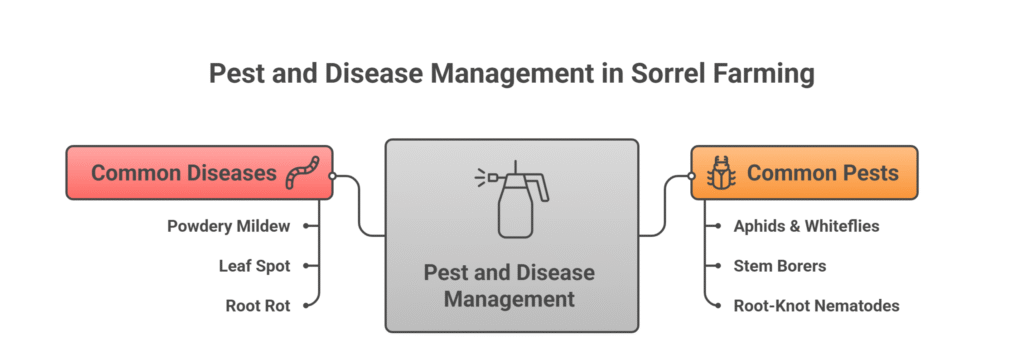
Common Diseases
a) Powdery Mildew
Powdery mildew appears as white, powdery fungal growth on the upper surface of leaves, stems, and sometimes young shoots, causing reduced photosynthesis, leaf distortion, and weakened plant vigor. It spreads rapidly under warm, dry conditions and poor air circulation. Early intervention helps prevent severe yield loss.
Control
- Sulfur-based Fungicides (Dusting sulfur or Wettable sulfur 80% WP): Mix 3–4 grams per liter of water for spraying.
- Potassium Bicarbonate: Mix 5 grams per liter for quick knockdown of fungal spores.
- Hexaconazole 5% EC: Mix 1 ml per liter of water for strong systemic protection.
b) Leaf Spot
Leaf spot is characterized by brown, dark brown, or black circular spots on the leaves, often surrounded by yellow halos. In severe cases, spots merge and cause premature leaf drop, reducing plant growth and productivity. High humidity, overhead irrigation, and poor airflow increase disease risk. Removing affected leaves helps reduce spread.
Control
- Mancozeb 75% WP: Mix 2.5 grams per liter of water and spray at 7–10 day intervals.
- Copper Oxychloride 50% WP: Mix 3 grams per liter of water; copper fungicides also act as preventive shields.
- Chlorothalonil 75% WP: Mix 2 grams per liter for effective control of fungal leaf spots.
c) Root Rot
Root rot is caused by fungal pathogens such as Pythium, Rhizoctonia, or Phytophthora, and it occurs mainly due to waterlogged or poorly drained soils. Plants show yellowing, wilting, and slow growth, and roots become brown, mushy, and foul-smelling. This disease is difficult to manage if not prevented, so maintaining good drainage is essential.
Control
- Metalaxyl 35% WP: Mix 1.5–2 grams per liter of water and drench around the root zone.
- Trichoderma harzianum (bio-fungicide): Apply 2–4 kg per hectare mixed with compost during soil preparation for long-term suppression.
- Carbendazim 50% WP: Mix 1 gram per liter and apply as a root drench; avoid repeated use to prevent resistance.
Harvesting
Harvesting of sorrel focuses on the mature, fleshy calyces rather than the true fruit, and typically begins 90–120 days after planting when the calyces are fully grown, plump, crisp, and brightly colored—usually deep red—yet still firm before becoming soft or shrunken; the process is labor-intensive and done manually by carefully separating the calyx from the seed pod, with harvesting continuing for 4–6 weeks since the calyces do not ripen uniformly.
Yield
Sorrel yield depends greatly on the cultivar, climate, and management practices, with a well-managed farm producing between 1,500 and 3,000 kg (1.5 to 3 tons) of fresh calyces per acre, and because fresh calyces are highly perishable, they are often dried immediately after harvest for preservation, with a drying ratio of approximately 10–12 kg of fresh calyces yielding 1 kg of dried calyces.
Cost of Investment per acre for Sorrel Farming
| S.N. | Category | Cost (NRs) |
| 1 | Land Preparation | 12,000 |
| 2 | Seed | 1,000 |
| 3 | Seed Sowing | 1,000 |
| 4 | Fertilizers and Manure | 8,000 |
| 5 | Irrigation | 6,000 |
| 6 | Weed Control (pre & post-emergence) | 2,000 |
| 7 | Pest & Disease Control | 2,000 |
| 8 | Harvesting | 3,000 |
| 9 | Miscellaneous Costs | 5,000 |
| Total Cost | 40,000 |
Income per acre from Sorrel Farming
| Particulars | Estimated Yield / Acre (Kg) | Market Price (NRs/kg) | Total Income (NRs) |
| Sorrel Calyces | 2,000 | 50 | 100,000 |
Analysis of Sorrel Farming Profit Per Acre
| Item | Amount (NRs.) |
| Total Income | 100,000 |
| Total Investment Cost | 40,000 |
| Net Profit | 60,000 |
Sorrel farming per acre involves a total investment of NRs 40,000 and can generate a total income of NRs 100,000, resulting in a net profit of NRs 60,000 per acre and a 150% return on investment; this high profitability is attributed to moderate input costs and the strong market value of sorrel calyces, while proper management of irrigation, pest control, and timely harvesting is essential to maintain yields and maximize returns.
Crop Calendar of Sorrel Farming
This calendar outlines the key activities and their approximate timing, assuming a planting date at the onset of the rainy season (e.g., March-April in many regions).
| Period (Weeks/Months After Planting) | Key Activities & Operations |
| Pre-Planting (1-2 Weeks Before) | Land Preparation: Clear field, deep plough, harrow 2-3 times, form raised beds. Basal Application: Incorporate 10-15 tons of well-decomposed FYM/compost and full doses of P₂O₅ (30-40 kg), K₂O (20-30 kg), and half of the N (20-25 kg) into the soil. |
| Planting (Week 0) | Sowing: Direct sow 1.5-2 kg of seeds (2-3 seeds/hole at 1-2 cm depth) or transplant 3-4 week old seedlings. Spacing: Maintain 90-120 cm between rows and 60-90 cm between plants. Biofertilizers: Apply Azospirillum, PSB, and Potash mobilizing bacteria (each 800g/acre). Initial Irrigation: Water immediately after planting/transplanting. |
| Early Growth Stage (Weeks 1-6) | Weed Control: Perform 2-3 rounds of manual weeding or apply mulch. Critical for first 6-8 weeks. Irrigation: Water deeply 1-2 times per week, depending on rainfall. Pest Monitoring: Start scouting for aphids, whiteflies, and stem borers. Intercropping: Plant short-duration crops (e.g., lettuce, radish) between rows. |
| Vegetative to Flowering Stage (Weeks 7-14) | Top-Dressing: Apply the remaining half of the Nitrogen (20-25 kg N) 4-6 weeks after planting. Pest/Disease Control: Monitor and manage aphids, whiteflies, stem borers, powdery mildew, and leaf spot as needed. Irrigation Management: Ensure consistent moisture, especially during flowering. |
| Calyx Development & Maturation (Months 3-4) | Reduced Irrigation: Gradually reduce watering 2-3 weeks before the main harvest to concentrate flavors. Pre-Harvest Check: Ensure pest and disease control sprays have passed their pre-harvest intervals. |
| Harvesting (Months 3-5) | First Harvest: Typically begins 90-120 days after planting. Method: Manually harvest mature, firm, and brightly colored calyces by separating them from the seed pod. Frequency: Harvest continues for 4-6 weeks as calyces mature unevenly. |
| Post-Harvest | Processing: Fresh calyces are highly perishable; often dried immediately (10-12 kg fresh ≈ 1 kg dried). Marketing: Sell fresh or dried calyces. Field Clean-up: Remove and destroy old plant debris to break pest and disease cycles. |
Sources
Food and Agriculture Organization (FAO)
University of California Agriculture & Natural Resources (UC ANR)
European Plant Protection Organization (EPPO)
Punjab Agricultural University (PAU)
Tamil Nadu Agriculture University (TNAU) – Agritech portal
Indian Council of Agricultural Research (ICAR)
Nepal Agricultural Research Council (NARC)
U.S. Department of Agriculture (USDA).
Ministry of Agriculture and Livestock Development (Nepal)
Disclaimer: This crop farming profits assume optimal conditions. Actual results may vary depending on climate, market prices, and farm management practices.


